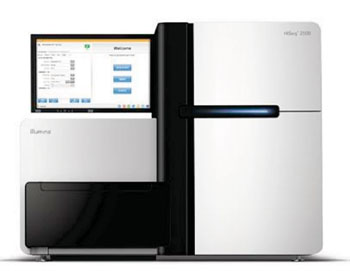New Genetic Disease Identified in Children
By LabMedica International staff writers
Posted on 09 Apr 2014
A new genetic disease that causes neurologic, muscle, eye and liver problems in children has been identified by a combination of modern gene-sequencing techniques. Posted on 09 Apr 2014
Mutations in the gene coding for N-glycanase 1 (NGLY1), an enzyme that recycles defective products from a cellular assembly line, was found in children who have varying degrees of movement disorders, including a characteristic combination of muscle contractions that causes abnormal tremulous movements.

Image: HiSeq2000 sequencing platform (Photo courtesy of Illumina).
Scientists at Lucile Packard Children’s Hospital (Palo Alto, CA, USA) and an international team of collaborators found eight children who through case reports and social media had clinical symptoms similar to an initial case and were found in a matter of months. All patients had global developmental delay, a movement disorder, and hypotonia. Other common findings included hypolacrima or alacrima (7/8), electroencephalography (EEG) abnormalities (7/8), elevated liver transaminases (6/7), microcephaly (6/8), abnormal brain imaging (6/8), diminished reflexes (6/8).
Exome sequencing was performed in the different collaborating laboratories using the HiSeq2000 platform (Illumina; San Diego, CA, USA) and the SureSelect Human All Exon 50 Mb Kit (Agilent; Santa Clara CA, USA) and for all patients, variants were confirmed by Sanger sequencing. The nonsense mutation c.1201A>T (p.R401X) was the most common deleterious allele identified, present in the homozygous state in five of eight cases and in the compound heterozygous state in one case. Two patients did not carry the c.1201A>T (p.R401X) mutation and their clinical phenotype was relatively mild by comparison.
The study confirmed that children with a defective NGLY1 gene do not make the N-glycanase enzyme. The scientists also observed that the children's liver biopsies contained an amorphous substance, which they suspected was an accumulation of protein that did not get recycled. Gregory Enns, MB, ChB, an associate professor of genetics in pediatrics and co-lead author, said, “This represents a complete change in the way we're going about clinical medicine. This is happening so quickly because of the integration of the families with the scientists, and because so many people are coming at this from so many angles.” The study was published on March 20, 2014, in the journal Genetics in Medicine.
Related Links:
Lucile Packard Children’s Hospital
Illumina
Agilent













.jpg)